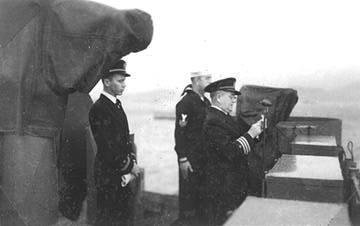
Cdr. Holdorff at microphone, Lt. White in rear.
On November 9, 1945, I succeeded Gordon Dewart as the executive officer. The trying times had arrived.
Captain Ernest Holdorff, who knew practically everything about the sea and cared little about U.S. Navy regulations, loved to be liked. When the crew members would beg for immediate detachment, heíd agree and say, "Go see the exec." The exec, of course was under strict orders to always say "No", thereby achieving the popularity of a grinch.
Our captain was known to take a drink or six and shout words better whispered. After several sad performances at the senior officer club, he was sent orders to depart immediately without awaiting arrival of his replacement, Cmdr.Wallace H.Gregg, USN, class of 1921.
On Dec. 12, L.T. Young, commander UNIT BAKER Service Division 103 operating from the USS Cascade (AD-16), also sent the following message to Lt. Maurice N. White:
"1. When directed by the Commanding Officer, you will consider yourself detached from the USS Cabildo (LSD-16) and such other duties as you have been assigned; you will immediately report to the Commanding Officer (USS Cabildo) for temporary duty as Commanding Officer of that vessel and as the relief of Commander E.B. Holdorff, (DM), USNR."The wheels churned immediately.. Department heads George Olson (engineering), John Macrone (gunnery) Rude Osolnik (communications), D.A. Carrara (medical), F.C. Mindich, Jr. (C&R) and Sherm Levin (navigation) reported only a few problems, although Larry Blanchard (supply) warned the stock of dry provisions was dangerously low and would last no more than a week."2. This duty effective until reporting Commanding Officer ordered by reference (d)."
The yeoman did magnificent work in cranking out the paper work so the individual reports could be consolidated into a single-spaced, three-page report to The Chief of Naval Operations.
Holdorff signed it. So did I, and a young man from land-locked Manilla, IA, who had never, and still hasnít, owned as much as a canoe, now was responsible for about 600 feet of expensive ship.
Both ship and crew were duded up for the change of command ceremony at 1445 the next afternoon. Lt. White stood in the background, still stunned concerning his rapid rise in authority, as Holdorff gave up command, then thanked and complimented the assembled crew.
Following that, I read my orders, saluted him and said, "Sir, I take command." After mentioning that all orders in effect were still in effect, I presented the departing captain with the commissioning flag.
My first official act as captain was appointing Sherm Levin as acting executive officer. My first tough decision was deciding not to occupy the captainís quarters, just to say Iíd been there. My first captainís mast didnít produce a single keel-hauling, or bread and water sentence.
When it turned out Gregg would be delayed in reporting, Cmdr. Hugh Lindsay was temporarily detached from a nearby ship and sent to temporarily replace the temporary C.O. of the Cabildo. With so much being temporary, Lindsay signed for the ship without much inspection or ceremony.
Our new captain finally showed up on 22 Dec., Lindsay waved goodbye, and there WAS an inspection. As a graduate of the Naval Academy, Gregg knew everything about rules and regulations but, as it turned out, considerably less about handling ships and men than did Holdorff.
As one of the first ships of its type, The Cabildo was actually in a development role. If it made sense to create an opening, Holdorff authorized it without asking, or sometimes reporting, to BuShips. It almost always was a sensible decision.
However, following late delivery of a large safe in Portsmouth, he had arbitrarily solved the problem of getting it down into the communications room by having a sizable square of deck cut out, then welded back.
This, more than anything, caused Gregg to see red and mutter he couldnít possibly sign for a ship with so many unauthorized alterations.
He could sign of course, and he did, but not before writing a letter to the high command detailing the free-wheeling approach of the previous permanent captain. It pleased me immensely when he included a sentence saying Lt. White was in no way responsible for not going by the book.
Temporary having been replaced by temporary prior to permanent,
I donít recall much of a coronation ceremony when Greg took
command. What I was to learn in my return to being executive
officer was working under Holdorff had been a delight.


USS Cabildo (LSD-16) Association Website - Last Revision April 1, 2006
This page is maintained by Warren Gammeter <Webmaster@usscabildo.org>.